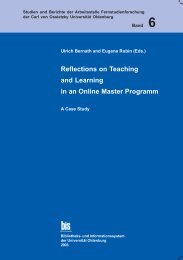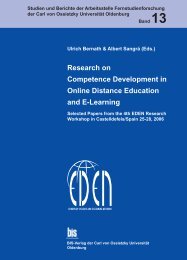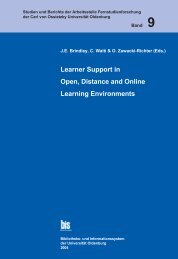Distance Education in Transition - Master of Distance Education ...
Distance Education in Transition - Master of Distance Education ...
Distance Education in Transition - Master of Distance Education ...
Create successful ePaper yourself
Turn your PDF publications into a flip-book with our unique Google optimized e-Paper software.
Digitised Learn<strong>in</strong>g Environments: New Possibilities and Opportunities<br />
methods from communications technology. Anthony Bates (1995, p. 202) assumes on<br />
the other hand that this process is merely the cont<strong>in</strong>uation <strong>of</strong> traditional social and<br />
work<strong>in</strong>g forms. We are faced here with basic problems which will have to be clarified<br />
theoretically.<br />
Summary<br />
Digitised learn<strong>in</strong>g environments open up new opportunities and chances not only for<br />
heteronomous but also for autonomous learn<strong>in</strong>g. We could conclude that they make<br />
directed heteronomous learn<strong>in</strong>g even more heteronomous, and self-directed autonomous<br />
learn<strong>in</strong>g a great deal more autonomous.<br />
With regulated heteronomous learn<strong>in</strong>g, the pedagogically substantiated comb<strong>in</strong>ation and<br />
<strong>in</strong>tegration <strong>of</strong> two or more modes <strong>of</strong> presentation means that multimedia teach<strong>in</strong>g contents<br />
can be <strong>of</strong>fered on a multi-sensory basis, which enables a precise close over-lapp<strong>in</strong>g <strong>of</strong><br />
stimuli whereby better sensory perception can be prepared, effected and strengthened. In<br />
addition, much higher levels <strong>of</strong> activity and <strong>in</strong>teractivity can be achieved.<br />
With autonomous learn<strong>in</strong>g, there is <strong>in</strong> addition a wealth <strong>of</strong> desirable preconditions. In<br />
the first place, the start<strong>in</strong>g situation is different because students are brought immediately<br />
<strong>in</strong>to an <strong>in</strong>teractive relationship with all types <strong>of</strong> <strong>in</strong>formation. This <strong>in</strong>creases accessibility<br />
to the f<strong>in</strong>d<strong>in</strong>gs <strong>of</strong> scientific research as well as to academic teach<strong>in</strong>g programmes stored<br />
<strong>in</strong> the media. The digital learn<strong>in</strong>g environment enables open learn<strong>in</strong>g situations and<br />
learn<strong>in</strong>g based on active <strong>in</strong>teractions. Instead <strong>of</strong> "passive" receptive learn<strong>in</strong>g we f<strong>in</strong>d the<br />
<strong>in</strong>dependent, self-determ<strong>in</strong>ed and self-regulated acquisition <strong>of</strong> knowledge based on the<br />
student's own strategies for search<strong>in</strong>g, f<strong>in</strong>d<strong>in</strong>g, select<strong>in</strong>g and apply<strong>in</strong>g. Learn<strong>in</strong>g by<br />
discovery and research can become a basic paradigm <strong>of</strong> academic teach<strong>in</strong>g. Furthermore,<br />
different forms <strong>of</strong> teleconferenc<strong>in</strong>g enable not only the academic discourse, someth<strong>in</strong>g<br />
which is neglected <strong>in</strong> traditional distance education, but also partnership and group<br />
work. Collaborative learn<strong>in</strong>g is given a much more important part to play than <strong>in</strong> traditional<br />
distance education, with the remarkable exception <strong>of</strong> the radio and television universities<br />
<strong>of</strong> Ch<strong>in</strong>a, where obligatory group meet<strong>in</strong>gs take place regularly. Video-conferenc<strong>in</strong>g<br />
establishes a new configuration for distance education, whose special features have been<br />
aptly characterised as "learn<strong>in</strong>g together apart" (Kaye, 1992, p. 1) and "teach<strong>in</strong>g face-t<strong>of</strong>ace<br />
at a distance" (Keegan, 1995, p. 108). Learners will have to be accustomed to deal<strong>in</strong>g<br />
with many virtual partners and communities.<br />
Today as well as <strong>in</strong> future it is important that we get away from the pedagogy <strong>of</strong> <strong>in</strong>struction<br />
and create and implement a pedagogy <strong>of</strong> enablement <strong>in</strong> its place, as Rolf Arnold (1993,<br />
p. 53) demands. The digitised learn<strong>in</strong>g environment will probably be the most efficacious<br />
"enabler" <strong>of</strong> <strong>in</strong>dependent and self-determ<strong>in</strong>ed learn<strong>in</strong>g. This approach is promis<strong>in</strong>g because<br />
it does not modify the traditional methods <strong>of</strong> presentational teach<strong>in</strong>g and receptive learn<strong>in</strong>g,<br />
but provides a completely different challenge for learn<strong>in</strong>g.<br />
On the whole, the pedagogical restructur<strong>in</strong>g required <strong>in</strong> distance education is deep and<br />
extensive. Some experts (e.g. Collis, 1996, p. XXII) even go so far as to demand a "reeng<strong>in</strong>eer<strong>in</strong>g"<br />
<strong>of</strong> distance education. We could <strong>in</strong> fact start to speak <strong>of</strong> the beg<strong>in</strong>n<strong>in</strong>g <strong>of</strong> a<br />
new era, <strong>in</strong> which distance education will develop <strong>in</strong>to an extraord<strong>in</strong>arily open, flexible<br />
and variable form <strong>of</strong> teach<strong>in</strong>g and learn<strong>in</strong>g which can be adapted and adjusted to the<br />
learn<strong>in</strong>g requirements <strong>of</strong> students, who will differ greatly from one another with regard<br />
69





